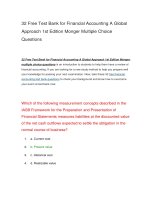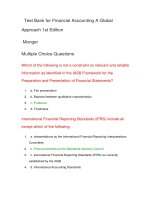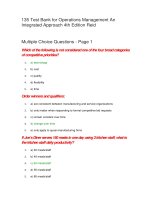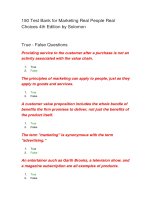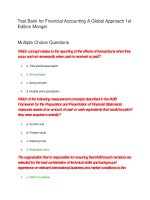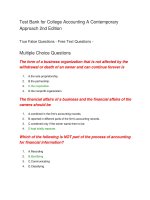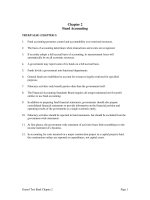Test bank for government and not for profit accounting concepts and practices 4th edition
Bạn đang xem bản rút gọn của tài liệu. Xem và tải ngay bản đầy đủ của tài liệu tại đây (106.06 KB, 13 trang )
Test Bank for Government and Not for Profit Accounting
Concepts and Practices 4th Edition
The main objective of a typical governmental or not-for-profit entity is to earn
a profit.
1. True
2. False
A government’s budget may be backed by the force of law.
1. True
2. False
Governmental entities have no need for an accounting system.
1. True
2. False
A government’s internal managers rely on general purpose financial
statements for a considerable amount of information about their
government.
1. True
2. False
Governments and not-for-profits may never engage in business-type
activities.
1. True
2. False
Lenders use the financial statements of governments and not-for profits just
as they would those of businesses, that is, to help assess the borrower’s
credit-worthiness.
1. True
2. False
Financial statements, no matter how prepared, do not directly affect the
economic worth of an entity.
1. True
2. False
The Financial Accounting Standards Advisory Board’s standards do not apply
to the federal Department of Treasury.
1. True
2. False
Governments may be subject to the same pressures that led to accounting
scandals like Enron.
1. True
2. False
The Governmental Accounting Standards Board establishes generally
accepted accounting principles for all state and local government entities, as
well as all not-for-profit entities.
1. True
2. False
A primary characteristic that distinguishes governmental entities from
business entities is
1. a) The need to generate revenues equal to or in excess of
expenditures/expenses.
2. b) The importance of the budget in the governing process.
3. c) The need to provide goods or services.
4. d) The correlation between revenues generated and demand for goods or
services.
A primary characteristic that distinguishes not-for-profit entities from
business entities is
1. a) The need to generate revenues equal to or in excess of
expenditures/expenses.
2. b) The importance of the budget in the governing process.
3. c) The need to provide goods or services.
4. d) The correlation between revenues generated and demand for goods or
services.
Which of the following characteristics distinguishes a governmental or notfor-profit entity from a business entity?
1. a) There is always a direct link between revenues generated and
expenditures/expenses incurred.
2. b) Capital assets are used to produce revenues and save costs.
3. c) Revenues are always indicative of demand for goods and services.
4. d) The mission of the entity will determine the goods or services provided.
The most significant financial document provided by a governmental entity is
the
1. a) The balance sheet.
2. b) The operating statement.
3. c) The operating budget.
4. d) The cash flow statement.
Which of the following statements is true?
1. a) Governments may engage in activities similar to activities engaged in by
for-profit entities.
2. b) There are a limited number of different types of governments.
3. c) All governmental entities engage in the same activities.
4. d) Managers may have a long-term focus and thereby sacrifice the short-term
liquidity of the entity.
Which of the following activities is NOT an activity in which a governmental
entity might engage?
1. a) Selling electric power.
2. b) Operating a golf course.
3. c) Operating a bookstore.
4. d) All of the above are activities that might be carried out by a government.
In which of the following activities is a not-for-profit entity least likely to
engage?
1. a) Providing educational services.
2. b) Providing health-care services.
3. c) Providing for terrorism defense.
4. d) Retail sales of cookies.
Which of the following can be affected by GAAP?
1. a) Legal ability to issue bonds.
2. b) Ability to balance the budget.
3. c) Amount reported as employee pension plan contributions.
4. d) Claims and judgments settled.
Which of the following characteristics is unique to a governmental entity?
1. a) The ability to have activities financed with tax-exempt debt.
2. b) The power to impose fees.
3. c) The ability to issue tax-exempt debt.
4. d) The ability to have activities financed by Federal grants.
To obtain a comprehensive understanding of a government’s fiscal health, a
financial analyst should obtain an understanding of which of the
following?
1. a) All of the resources owned by the governmental entity.
2. b) All of the resources which may be summoned by a governmental entity.
3. c) Demographic data about the residents served by the governmental entity.
4. d) All of the above.
Which of the following is common to both governments and not-for-profit
entities but distinguishes these entities from for-profit entities?
1. a) The budget is a legal, financial document.
2. b) Revenues are usually indicative of demand for goods or services.
3. c) There is direct matching of revenues and expenses.
4. d) There are no defined ownership interests.
Which of the following is NOT a purpose of external financial reporting by
governments? External financial reports should allow users to
1. a) Assess financial condition.
2. b) Compare actual results with the budget.
3. c) Assess the ability of elected officials to effectively manage people.
4. d) Evaluate efficiency and effectiveness.
Which of the following is NOT a reason why users need governmental and notfor-profit external financial statements?
1. a) To determine the ability of the entity to meet its obligations.
2. b) To determine the ability of the entity to continue to provide services.
3. c) To predict future fiscal solvency.
4. d) To evaluate the overall profitability of the entity.
Users of government financial statements should be interested in information
about compliance with laws and regulations for which of the following
reasons?
1. a) To determine if the entity has complied with bond covenants.
2. b) To determine if the entity has complied with taxing limitations.
3. c) To determine if the entity has complied with donor restrictions on the use
of funds.
4. d) To determine all of the above.
Which of the following is NOT generally considered a main user of
government and not-for-profit entity external financial statements?
1. a) Investors and creditors.
2. b) Taxpayers.
3. c) Donors.
4. d) Internal managers.
Which of the following is a probable use a donor would make of the external
financial statements of a not-for-profit entity?
1. a) To determine the proportion of entity resources directed to programs as
opposed to fund-raising.
2. b) To determine the creditworthiness of the entity for investment purposes.
3. c) To determine the salaries paid to all employees of the entity.
4. d) To determine the budget of the entity.
A regulatory agency would use the external financial statements of a local
government for which of the following purposes?
1. a) To assure that the entity is spending and receiving resources in accordance
with laws, regulations or policies.
2. b) To determine how resources should be allocated.
3. c) To exercise general oversight responsibility.
4. d) To do all of the above.
Which of the following constituency groups would be most likely to evaluate
government financial statements to determine likely areas in which to
achieve cost-savings?
1. a) Creditors.
2. b) Union officials representing the government’s employees.
3. c) Federal agencies that provide purpose-restricted grants.
4. d) Students of governmental accounting.
Which of the following objectives is considered to be the cornerstone of
financial reporting by a governmental entity?
1. a) Accountability.
2. b) Budgetary compliance.
3. c) Interperiod equity.
4. d) Service efforts and accomplishments.
Which of the following is an objective of financial reporting by governmental
entities as established by GASB?
1. a) Financial reporting should assist users in assessing the management skills
of top management.
2. b) Financial reporting should assist users in determining if current-period
revenues were sufficient to pay for current-period services.
3. c) Financial reporting should assist users in evaluating the cash management
operations of the governmental entity for the year.
4. d) Financial reporting should assist users in assessing whether the
government provided appropriate services to its constituents in the current
year.
Which of the following is an objective of financial reporting for not-for-profit
entities as established by FASB? Financial reporting should provide
information that is useful to present and potential resource providers and
other users in:
1. a) Assessing the types of services provided and the need for those services.
2. b) Assessing the services provided and the entity’s ability to earn a profit.
3. c) Making rational decisions about the allocation of resources to those
organizations.
4. d) Assessing how managers have managed personnel.
As used by GASB, interperiod equity refers to which of the following?
Financial reporting should:
1. a) Demonstrate compliance with finance-related contractual requirements.
2. b) Provide information to determine whether current-year revenues were
sufficient to pay for current-year services.
3. c) Demonstrate whether resources were obtained and used in accordance
with the entity’s legally adopted budget.
4. d) Provide information to assist users in assessing the government’s
economy, efficiency, and effectiveness.
Given a specific set of data, the basis of accounting selected by or imposed
on a governmental entity will least affect which of the following?
1. a) Determining whether or not the governmental entity has a balanced
budget.
2. b) Determining whether or not the governmental entity has the ability to
issue debt.
3. c) Determining whether or not certain economic events occurred.
4. d) Determining the annual payments to a government-sponsored pension
plan.
The basis of accounting selected by or imposed on a governmental entity can
influence which of the following?
1. a) A decision to contract-out a specific service rather than provide that
service itself.
2. b) The amount of salary increases proposed by union negotiators.
3. c) The amount that is available to spend on a donor-specified project or
service.
4. d) All of the above.
The Governmental Accounting Standards Board is the primary standardsetting body for:
1. a) All governments.
2. b) All state and local governments.
3. c) All governments and all not-for-profit entities.
4. d) All state and local governments and all not-for-profit entities.
Under certain circumstances a governmental entity might use standards
established by which of the following standard-setting bodies?
1. a) GASB.
2. b) FASB.
3. c) AICPA.
4. d) All of the above.
The primary standard-setting body for accounting and financial reporting by a
state-supported college or university is:
1. a) GASB.
2. b) FASB.
3. c) AICPA.
4. d) All of the above.
In descending order, the hierarchy of GAAP applicable to a church-owned
college may be:
1. a) FASB Statements and Interpretations, FASB Technical Bulletins, AICPA
Industry Audit Guides, FASB Implementation Guides, other accounting
literature—including GASB Standards.
2. b) FASB Statements and Interpretations, FASB Technical Bulletins, FASB
Implementation Guides, AICPA Practice Bulletins (if cleared by FASB).
3. c) GASB Statements and Interpretations, AICPA Industry Audit Guides, GASB
Implementation Guides, other accounting literature—including FASB
Standards.
4. d) GASB Statements and Interpretations, GASB Technical Bulletins, AICPA
Industry Audit Guides, AICPA Practice Bulletins (if cleared by GASB), GASB
Implementation Guides, other accounting literature—including FASB
standards.
Which of the following entities was a principal in creating the FASAB?
1. a) U.S. Congress.
2. b) Office of Management and Budget.
3. c) Governmental Accounting Standards Board.
4. d) Securities and Exchange Commission.
The purpose of the FASAB is to:
1. a) Establish accounting standards for not-for-profit entities.
2. b) Establish accounting standards for federal entities.
3. c) Establish accounting standards for all governmental entities.
4. d) Establish accounting standards for non-federal governmental entities.
